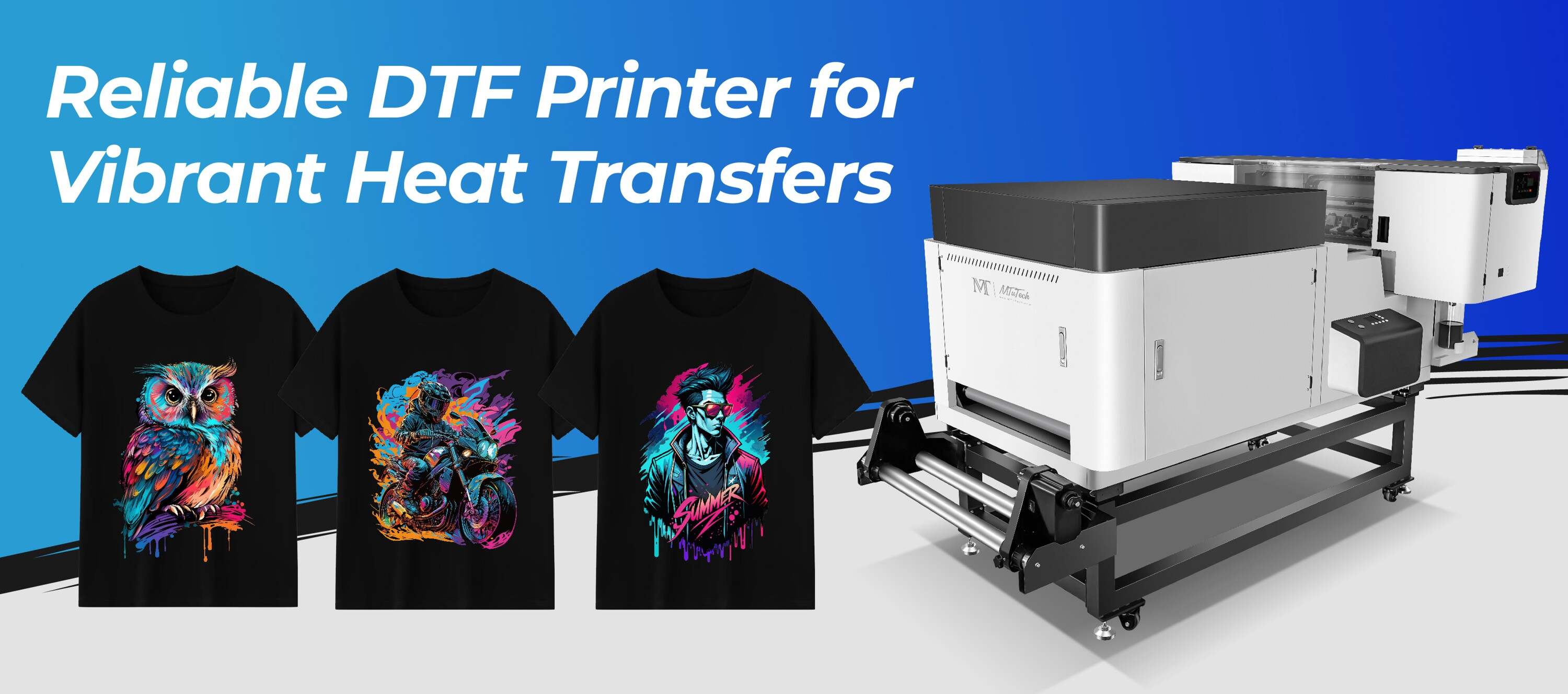Introduction
Digital printing technology has revolutionized the custom apparel and textile industries, with Direct-to-Garment (DTG) and Direct-to-Film (DTF) printing at the forefront. Both methods offer unique advantages, but understanding their differences and applications can be crucial for businesses looking to expand their capabilities. This blog post will delve into the intricacies of both DTG and DTF printers, helping you decide which technology fits your needs best.
What is DTG Printing?
DTG printing refers to the process of directly printing designs onto textiles, typically using specialized inkjet technology. This method has gained popularity due to its ability to produce detailed, vibrant images with a relatively straightforward setup. The inks used are water-based, making the process an environmentally-friendly option.
How Does DTG Printing Work?
The DTG printing process begins with pre-treating the fabric—usually cotton or a cotton blend—to ensure that the inks adhere properly. Here’s a simplified version of the process:
Pre-Treatment: The fabric is sprayed or rolled with a pre-treatment solution, which allows the ink to bond effectively with the fibers.
Printing: Once pre-treated, the material is placed in a DTG printer, which prints the design using inkjet technology.
Curing: After printing, the fabric goes through a curing process using a heat press or conveyor dryer to set the ink.
Advantages of DTG Printing
DTG printing comes with several key benefits:
High Detail: Capable of providing intricate designs with complex colors.
Short Run Capability: Ideal for small batches and on-demand printing, reducing inventory costs.
Eco-Friendly: The water-based inks used are less harmful to the environment.
What is DTF Printing?
DTF printing, or Direct-to-Film printing, is a more recent innovation in textile printing. It transfers ink from a film to a garment, allowing for vibrant prints on various materials. Unlike DTG, which prints directly onto the fabric, DTF printing involves an intermediary step that often enhances the versatility of the printing process.
How Does DTF Printing Work?
The DTF printing process can be broken down into several steps:
Printing on Film: The design is printed onto a special transfer film using DTF inks.
Applying Powder: Adhesive powder is applied to the printed film while the ink is still wet.
Heat Curing: The film with the adhesive is then cured with heat to ensure that the powder adheres to the ink.
Transfer to Fabric: The final step involves heat pressing the film onto the garment, transferring the design.
Advantages of DTF Printing
DTF printing has quickly become a favorite among apparel decorators for various reasons:
Versatility: Works on a range of materials, including cotton, polyester, and blends, making it ideal for various applications.
Durability: DTF prints tend to have excellent wash and wear durability compared to traditional heat transfers.
Vibrancy: Produces bright, vivid colors with a finished touch that often feels softer against the skin.
Comparing DTG and DTF Printers
Choosing between DTG and DTF printing ultimately depends on your specific needs. Below, we compare some crucial points:
Cost-Effectiveness
DTF printers typically have a lower initial cost than DTG printers, making them a more accessible option for small businesses and hobbyists. However, DTG printing can result in lower costs per unit for larger volumes due to its production speed.
Material Compatibility
DTG printing primarily works best on 100% cotton fabrics, while DTF can print on a much wider range of materials. If you plan to print on polyester or blends, DTF may be the better option.
Print Quality
While both methods result in high-quality prints, DTG printing excels in intricate designs and color gradients. DTF printing provides vibrant colors and durability for a wider range of applications.
Production Speed
For bulk orders, DTG printers are often faster since they can print directly on garments without needing transfer film. DTF, however, can offer quick turnaround times for multi-material projects.
Key Features to Look For
When choosing between DTG and DTF printers, consider the following key features:
Print Resolution: Higher DPI (dots per inch) ensures better image quality.
Ink Type: Look for printers that use high-quality inks for durability and wash resistance.
Ease of Use: User-friendly interfaces and software can significantly impact productivity.
Support and Service: Consider the manufacturer's service quality and product support options.
Conclusion
Both DTG and DTF printing technologies have their unique strengths and applications. DTG is best suited for high-detail prints on natural fabrics, while DTF offers versatility and durability across various materials. Understanding these differences will help you make an informed choice based on your printing needs.
Whether you’re just starting in the custom apparel business or looking to expand your offerings, both methods can provide exceptional quality and value. Explore our high-quality DTF printers here to find a solution that fits your business goals.
FAQ
Can I use DTF printers on all types of fabric?
Yes, DTF printers are versatile and can print on various fabrics, including cotton, polyester, nylon, and blends, making them a suitable option for different projects.
Are prints from DTF more durable than DTG?
Generally, DTF prints are known for their durability and wash resistance, often outperforming DTG prints in terms of longevity, especially on synthetic fabrics.
What are the running costs associated with DTG and DTF printers?
DTG printers may have higher ink costs due to specialized inks needed for direct printing, while DTF printers often have lower ink consumption per print, making them more cost-effective for larger projects.
Is it possible to print white ink using both DTG and DTF printers?
Yes, both DTG and DTF printers have the capability to print white ink, allowing for designs on colored or dark fabrics. However, the process and ink formulations may differ.
What is the typical turnaround time for DTG and DTF printing?
DTG printing is generally faster for bulk orders due to direct printing, while DTF has quick turnaround capability but may require additional steps for film preparation.

